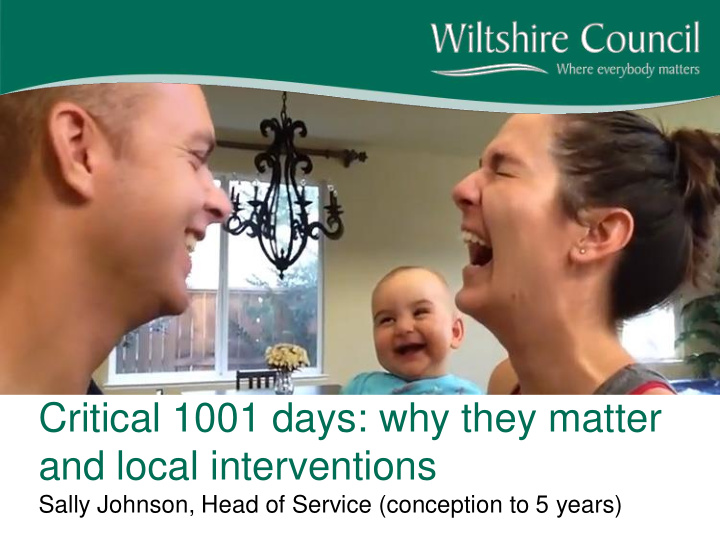



Critical 1001 days: why they matter and local interventions Sally Johnson, Head of Service (conception to 5 years)
A time of risk and opportunity • 41% serious case reviews under 1 year • Rapid brain growth and development • Laying the foundation that affects the course of our later lives - relationships, cognitive, social, emotional development and physical health • Parents often receptive • Can potentially make the biggest difference • Makes economic sense ‘Taking a person from the potential to the actual’ (Leach, 2017)
In the womb ….. Relationship Social support Housing Finance with partner networks Alcohol / drugs Emotional and mental health Diet/ nutrition Smoking
O’Donnell et al, 2014
Pawlby et al, 2009
• own attachment Maternal representations experiences • baby, herself as in pregnancy mother, relationship with own mother • baby with mind of their own • Parent’s representations of self and others are reactivated and reorganised • Research shows relationship with the unborn predicts • Quality of parent-infant interaction after birth • Infant’s attachment at 1 year (Barlow, 2017)
Early relationships are key • Psychological and sociological impact – early attachments influence self-confidence, courage to explore, relate to others and future relationships • Brain development – attuned to quality of early relationship and designed to fit into early mothering environment
Brain architecture • Neurones: the building materials • Connect to form circuits: foundations • Experiences and environment shape brain architecture • Serve and return interactions strengthen neural pathways • Pruning the connections; brain adapts to environment • Brain becomes what the brain does!
Building for the future Nelson, CA (2000)
The impact of stress on brain development Learns to manage Positive stress – natural day to day stress stress e.g. meeting new people Tolerable stress – very stressful event Others there to help turn off stress e.g. very ill Toxic stress – prolonged extreme stress Damaging to brain e.g. neglect or abuse development Risk a poor long term outcomes – physical and mental health problems, development issues
Relationships are central
Local evidence based programmes • Family Nurse Partnership - intensive support for expectant teenage parents U19 at conception • Baby Steps - perinatal group based programme for vulnerable parents / those who would benefit from additional support. - Pre-programme home visit followed by 10 interactive sessions (9 group based and one post birth home visit) Both relationship based programmes
Baby Steps 2 year evaluation: engagement Stage Overall Safeguarding concerns Referral to home visit 57% 62% Home visit to participation 73% 65% Participants completing ≥6 74% 62% sessions
Outcomes for validated measures (mothers only) Direction Measure Before After Difference of travel ↑ HADS (Anxiety)* 6.5 5.7 -0.9 ↑ HADS (Depression) 4.3 4.0 -0.2 ↑ PAI* 64.9 68.2 3.3 ↓ RQI 40.0 37.8 -2.2
Safeguarding concerns downgraded CASE Start of Baby Steps End of the Baby Steps programme STUDY A Social care / child protection / 2 Plan downgraded previous children adopted Baby at home with mum B Social care / child in need / violent Universal by Baby Steps session 9 partner but living alone Social worker no longer involved C Social care / LAC / older child with Plan downgraded when baby born. New grandmother. Unborn baby CIN baby stayed with mum. Later moved to universal D Social care / previous DA / Twins at home after birth, support from previous children adopted / sister. Partner has gone. expecting twins / new partner E Social care / LAC / abusive partner No longer with partner. Moved to refuge. / First child adopted due to DA / No longer on CIN unborn baby CIN
Other benefits • Identifying risks - home visits • Enabling disclosure • Parents better prepared, more positive and confident, better understanding of baby, secure, supported - >90% • Building client confidence to access support • Linking client with local support – e.g. children’s centres • Partnership working
Any questions?
Recommend
More recommend